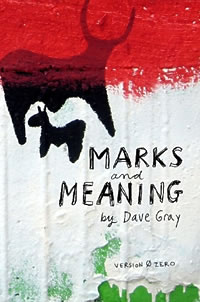 Last week, I told you about Dave Gray’s fascinating new book about visual thinking, Marks and Meaning. Today, I’d live to dig a bit deeper, taking a closer look at a concept from it called “successive approximation” that can help you to become a better visual mapper.
Last week, I told you about Dave Gray’s fascinating new book about visual thinking, Marks and Meaning. Today, I’d live to dig a bit deeper, taking a closer look at a concept from it called “successive approximation” that can help you to become a better visual mapper.
Successive approximation is a problem solving strategy that many of us use without even being aware of it. Conversation between two people is a perfect example, Gray explains. You say something to the other person, and they reply. Based on their verbal and non-verbal feedback to what you said, you discover something about that person, which you then incorporate into your next reply.
How does this concept apply to visual thinking? When you’re first trying to solve a problem or create a plan, your first efforts are an approximation, a guess – an incomplete picture, if you will. This is especially true if you’re facing a unique problem or challenge that you’ve never experienced before, because in situations like this, you have no prior context to rely upon. In these types of situations, your problem-solving power comes not from using a linear style of thinking, but from getting feedback and then improving your thinking, in a fast-moving, iterative cycle, as Gray explains here:
“If you wait until your plan is complete – till every contingency is covered – you will never get anywhere. Progress, not perfection, is the goal… Build feedback loops into your execution mechanisms, so you can improve as you move… (Use) feedback… to enrich your thinking and improve your understanding of the situation. Feedback is the most important and often neglected piece of the puzzle. When you first contextualize, you are guessing. When you incorporate feedback and use it to re-contextualize, you are improving… Success does not come from perfect execution, but from a fast-moving cycle of continuous improvement. The faster you go, the more you learn. The more you learn, the stronger you get.”
Finally, how does this concept apply specifically to mind mapping? Your first iteration of a mind map is an approximation of the existing situation. To get feedback, you can share the map with others; they can annotate the map with their comments, or you can simply walk away from the map for a day or two, and then come back to it with fresh eyes. In either case, you are improving your map from a rough approximation to a more accurate representation of the situation, using an iterative feedback cycle.
Mind mapping software has another benefit when it comes to successive approximation: As you implement your project, you can incorporate what you’ve learned into your map. In this way, it becomes a living document, not something you create once and then forget about. It becomes a management tool that you can utilize to help envision and make mid-course corrections to keep your project on track.
I think this is a powerful concept that is very relevant to the needs of many business-oriented visual mappers. What do you think?

Leave a Reply